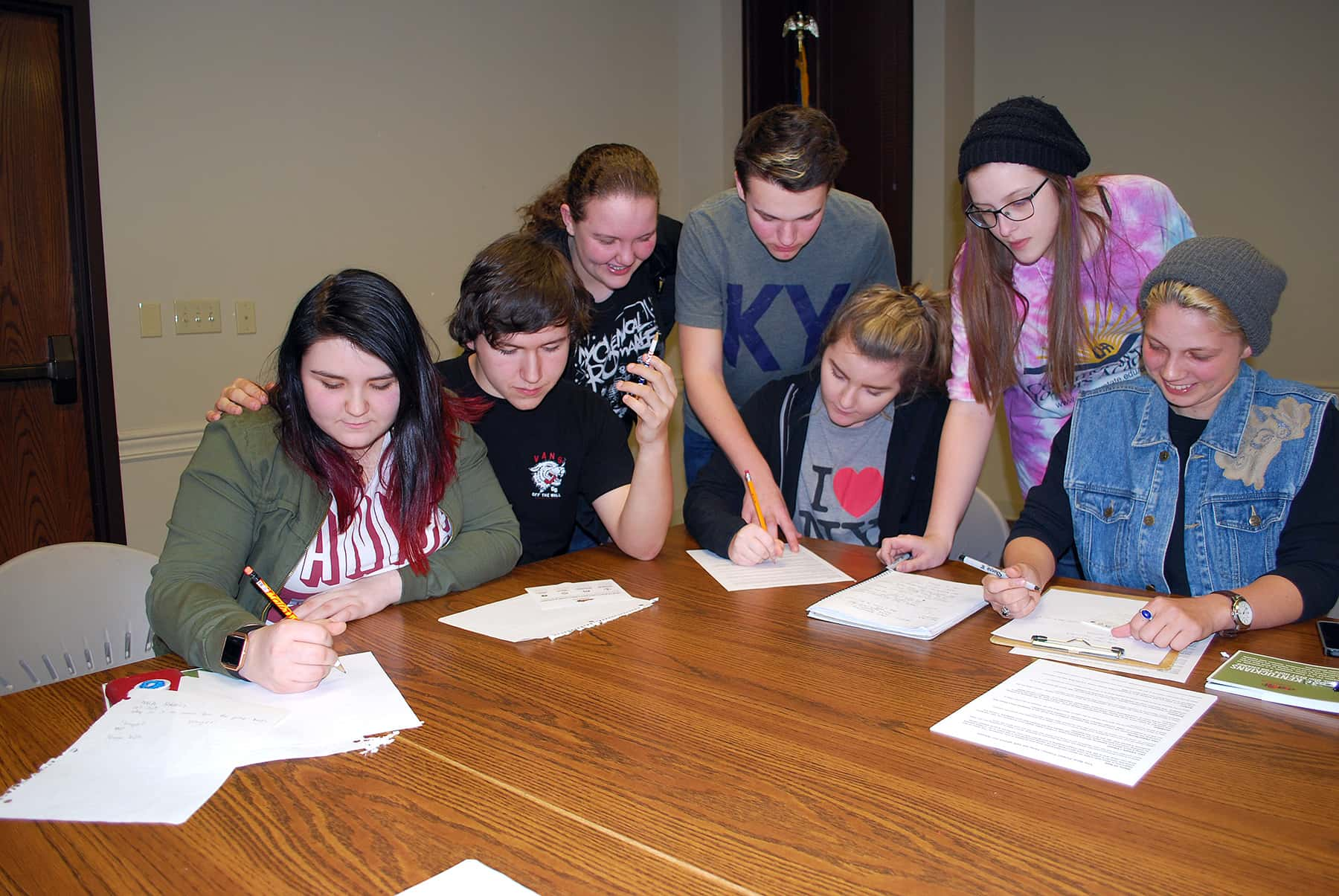
Students from Marshall and Calloway counties and Murray High discuss plans for the Marshall County/West Kentucky March for Our Lives scheduled for 1 p.m. March 24 at Memorial Park in Calvert City. From left, seated are: Lela Free and Seth Adams, both 14 and freshmen at Marshall County High; Makayla Watkins, 17 and a senior at Calloway County High; and Lesley Garrett, organizer apprentice with Kentuckians for the Commonwealth Western Kentucky Chapter in Bowling Green. From left, standing are: Sarah Jacobs, 16 and a junior at Murray High; Jack Daughaday, 15 and a sophomore from Calloway County High; and Lexi Fortner, 17 and a senior at Murray High.
By Bobbie Foust
Special to Marshall County Daily
An expert in treating gunshot wounds and a hunting guide/folk entertainer are scheduled speakers at the Marshall County/Western Kentucky March for Our Lives at 1 p.m. March 24 at Memorial Park in Calvert City.
Dr. Sterling Haring, Vanderbilt Medical Center physician who treated students injured in the January 23 shooting at Marshall County High School, and Alonzo Pennington, a well-known Princeton hunting guide and musician, will address an anticipated crowd of more than 600.
The march, organized by Marshall County, Calloway County and Murray high school students ranging from 14 to 17, was scheduled to coincide with the National March for Our Lives in Washington, D.C. Students are receiving organizational support from Kentuckians for the Commonwealth and Pennyroyal Indivisible
It was the idea of Heather Adams and her 14-year-old son, Seth Adams, a freshman at Marshall County High. Seth was nearby when the shooting occurred and is still dealing with its aftermath.
“My mom brought it up,” Seth Adams said following the second planning session. “She said, ‘We’re thinking about doing a rally — just a March for Life sort of thing, and then get together and discuss the next step — how we can increase safety; how can we change the culture.’”
Adams was in the high school cafeteria the fateful morning of Jan. 23 when a fellow student opened fire on classmates gathered in the school commons. “I was about 20 yards from where it happened,” he said, noting he didn’t see it, only heard it. “I was turned away; we were eating donuts in the cafeteria. … We — a group of six friends, had all gotten up to throw away our trash and put up our trays — and that’s when it happened.
“All I recall is flinging my backpack about two tables over and sprinting out the back of the cafeteria into a classroom,” Adams said. “We locked the door; we were in there with a teacher. I had my phone, and I ended up calling my Mom and texting all my friends. … I only thought he fired three shots — that’s where in my mind — I start losing it until I got back into the room. I remember three shots happening and the exact moment that I realize there was a shooter. The exact details get fuzzier.”
Adams conceded it was difficult returning to the classroom. “I had, and still have, anxiety, sometimes from people yelling and if there are loud noises; and sometimes just from my own thoughts, my own internal dialog getting out of control, and that kind of thing. I think it’s getting better; I think, mentally, I’m improving.”
Adams believes organizing the March for Our Lives to help stop mass shootings, change the culture, and unify the community is helping him deal with the emotional trauma he endured.
“Just getting together with like-minded people, just meeting new people, new friends, talking to them about their experiences, their sympathies, and their thoughts, helps,” he said. “Just gathering together, and writing down ideas — it’s like a group therapy almost, it’s like a therapeutic process. That said, this is more than a political organization. This march is for unity, and a sense of moving forward, a sense of bringing change to the community and change to our culture and change to our laws even, and creating a better environment for everybody — for the students at Marshall County, for everybody in Marshall County and surrounding communities, and in Kentucky and in our country.”
Heather Adams, Marshall’s lead organizer, Shannon Jacobs, Calloway’s lead organizer, Megan Meyer, of Pennyroyal Indivisible, and Maysoon Khatib, an adjunct professor of organizational communications at Murray State University, and Gloria Hollifield, a newswoman with The Lake News and Heather Adams’ mother, are acting in a support role, and allowing the students to take the lead.
Kentuckians for the Commonwealth relies on its years of organizing experience to guide the students. The organization supports the students with a longer-term strategy and messaging. It is contributing what the group’s organizers call its “new power frame,” which is to talk about issues. It starts with the individual participant’s own story of his/her background, values; the opportunities; the problem and the action to solve the problem. KFTC also supports the action a group chooses, which includes voter registration and voter engagement, and it provides the infrastructure for bringing issues to legislators’ attention.
For more information go to: March for Our Lives Marshall County/West Kentucky.
As she left the meeting, Hollifield noted March 24 is her birthday. “I’ll be 63 years old, and these kids deserve 63 years too.”
